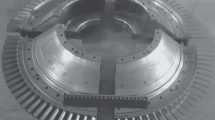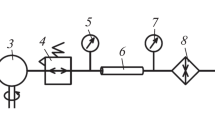Abstract
The profile of several dents on a propeller with a diameter of about 2500 mm were measured by the stylus probe method. The predominant mechanism of action during cavitation was found to be the impact of jets occurring at an angle to the blade surface. The diameter of the jets reaches 5 mm, and the impact velocity is several hundred meters per second, while the deformation of the material of dents from single blows of the jets reaches 10%, and the depth of the dents is 0.3 mm. At such depths of dents, the thickness of the hardened layer under the surface of the wear zone can be 3 mm or more, which allows evaluating the contribution of electrochemical corrosion to the total wear of propellers during cavitation in a different way. When testing screw alloys for cavitation wear using ultrasonic magnetostrictive vibrators, the replacement of fresh water with sea water is unreasonable; the corrosive action of sea water can lead to plasticization of the surface layer of the metal due to facilitated dislocation discharge. This is unlikely on propellers, since the depths of work hardening of the blade surface layer are two orders of magnitude greater than the thickness of the plastically deformed layer obtained in experiments with ultrasonic vibrators.




Similar content being viewed by others
REFERENCES
Sreedhar, B.K., Albert, S.K., and Pandit, A.B., Cavitation damage: theory and measurements—A review, Wear, 2017, vols. 372–373, pp. 177–196.
Kumar, P. and Saini, R.P., Study of cavitation in hydro turbines—A review, Renewable Sustainable Energy Rev., 2010, vol. 14, pp. 374–383.
Gravalos, I., Kateris, D., Xyradakis, P., and Gialamas, Th., Cavitation erosion of wet-sleeve liners: case study, J. Middle Eur. Constr. Des. Cars, 2006, vol. 4, no. 3, pp. 10–16.
Georgievskaya, E.P., Kavitatsionnaya eroziya grebnykh vintov i metody bor’by s nei (Cavitation Erosion of Propeller Screws and Its Prevention), Leningrad: Sudostroenie, 1978.
Fomin, V.V., Gidroeroziya metallov (Hydroerosion of Metals), Moscow: Mashinostroenie, 1977.
Gorbachenko, E.O. and Tsvetkov, Yu.N., Cavitation wear prediction of propeller materials based on surface roughness measurement data, Tr. Krylovsk. Gos. Nauchn. Tsentra, 2019, vol. 4, no. 390, pp. 53–66.
Preece, C.M. and Brunton, J.H., A comparison of liquid impact erosion and cavitation erosion, Wear, 1980, vol. 60, pp. 269–284.
Brunton, J.H. and Rochester, M.C., Erosion of solid surfaces by the impact of liquid drops, in Erosion, Preece, C.M., Ed., New York: Academic, 1979, pp. 185–248.
Tabor, D., The hardness and strength of metals, J. Inst. Met., 1951, vol. 79, no. 1, pp. 1–18.
Kozyrev, S.P., Gidroabrazivnyi iznos metallov pri kavitatsii (Hydroabrasive Wear of Metals during Cavitation), Moscow: Mashinostroenie, 1971.
Author information
Authors and Affiliations
Corresponding author
Additional information
Translated by A. Ivanov
About this article
Cite this article
Tsvetkov, Y.N., Gorbachenko, E.O. & Fiaktistov, Y.O. Analysis of the Geometry of Dents on a Propeller Blade Surface during Cavitation Wear. J. Frict. Wear 42, 17–22 (2021). https://doi.org/10.3103/S1068366621010116
Received:
Revised:
Accepted:
Published:
Issue Date:
DOI: https://doi.org/10.3103/S1068366621010116




